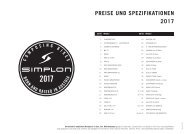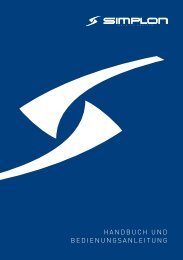201506_0276001SPI_System_Manual_25_45kmh_PerfLine_Intuvia_WEU_oReg
You also want an ePaper? Increase the reach of your titles
YUMPU automatically turns print PDFs into web optimized ePapers that Google loves.
English–5<br />
Battery Charge-control Indicator<br />
The battery charge-control indicator i displays the charge<br />
level of the eBike battery pack, not that of the on-board computer’s<br />
internal battery pack. The charge level of the eBike<br />
battery pack can also be checked on the LEDs of the battery<br />
pack itself.<br />
On indicator i, each bar of the battery pack symbol is equivalent<br />
to a capacity of approx. 20 %:<br />
The eBike battery pack is fully charged.<br />
The eBike battery pack should be recharged.<br />
The LEDs of the charge-control indicator on the<br />
battery pack extinguish. The capacity for assisting<br />
the drive has been used up, and assistance is gently switched<br />
off. The remaining capacity is made available for the lighting<br />
and the on-board computer. The indicator flashes.<br />
The capacity of the eBike battery pack is enough for about<br />
2 hours of lighting. This does not account for other consumers<br />
(e.g. automatic gearbox, charging external devices at the<br />
USB port).<br />
If the on-board computer is removed from the holder 4, the<br />
last displayed battery charge level is saved.<br />
Setting the Assistance Level<br />
On the operating unit 10 you can set how much the eBike<br />
drive assists you while pedalling. The assistance level can be<br />
changed at any time, even while cycling.<br />
Note: For individual versions, it is possible that the assistance<br />
level is pre-set and cannot be changed. It is also possible that<br />
less assistance levels are available for selection than listed<br />
here.<br />
The following assistance levels (max.) are available:<br />
– “OFF”: The motor assistance is switched off, and the eBike<br />
can be moved as a normal bicycle only by pedalling. The<br />
push assistance/start assistance cannot be activated in<br />
this assistance level.<br />
– “ECO”: Effective assistance at maximum efficiency for<br />
maximum cruising range<br />
– “TOUR”: Uniform assistance, for touring with long cruising<br />
range<br />
– “SPORT”: Powerful assistance for sportive riding off road<br />
as well as for urban traffic<br />
– “TURBO”: Maximum assistance, supporting highest cadence<br />
for sportive riding<br />
To increase the assistance level, press the “+” 13 button on<br />
the operating unit until the desired assistance level appears in<br />
the display b. To decrease the assistance level, press the<br />
button“–” 12.<br />
The requested motor output is displayed in indicator a. The<br />
maximum motor output depends on the selected assistance<br />
level.<br />
Assistance Level Assistance Factor* (Derailleur)<br />
Cruise Speed CX<br />
“ECO” 50 % 55 % 50 %<br />
“TOUR” 120 % 120 % 120 %<br />
“SPORT” 190 % 190 % 210 %<br />
“TURBO” 275 % 275 % 300 %<br />
* The motor output can vary for individual versions.<br />
When the on-board computer is removed from the holder 4,<br />
the last indicated assistance level is stored; the motor-output<br />
indicator a remains empty.<br />
Switching the Push/Start Aid On/Off<br />
With the speed version, the push aid can also be used as a<br />
start aid. The start aid is switched off at 18 km/h.<br />
The push/start aid can make it easier for you to push or start<br />
the eBike. The speed of this feature depends on the selected<br />
gear and depending on the model, can reach a maximum of<br />
6 km/h or 18 km/h. The lower the selected gear, the lower the<br />
speed of this function (at full capacity).<br />
The push/start aid function may only be used when<br />
pushing or starting the eBike. If the wheels of the eBike<br />
have no contact with the ground when using the push aid,<br />
then there is risk of injury.<br />
To switch on the push/start aid, press and hold the “WALK”<br />
14 button on the operating unit. The eBike drive is switched on.<br />
Note: The push assistance/start assistance cannot be activated<br />
in the “OFF” assistance level.<br />
The push/start aid is switched off if one of the following<br />
occurs:<br />
– you release the “WALK” 14 button,<br />
– the wheels of the eBike are blocked (e.g. by actuating the<br />
brakes or impacting against an obstacle),<br />
– the speed exceeds 6/18 km/h.<br />
Switching bike lights on/off<br />
In the model in which the lighting is powered by the eBike system,<br />
the front and rear lights can be switched on and off at the<br />
same time via the on-board computer with button 2.<br />
When the lighting is switched on “Lights on” appears and<br />
when the lighting is switched off “Lights off” appears for approx.<br />
1 s in text indication d. The lighting symbol c is displayed<br />
when the light is on.<br />
Switching the bike light on and off has no effect on the back<br />
lighting of the display.<br />
Version Speed: Daytime running lights are always provided<br />
in this option. When you switch on the eBike system (see<br />
“Switching the eBike <strong>System</strong> On/Off”, page English–3), the<br />
lights will also be switched on. The bike lights cannot be<br />
switched off with button 2.<br />
Bosch eBike <strong>System</strong>s 0 276 001 SPI | (3.6.15)








